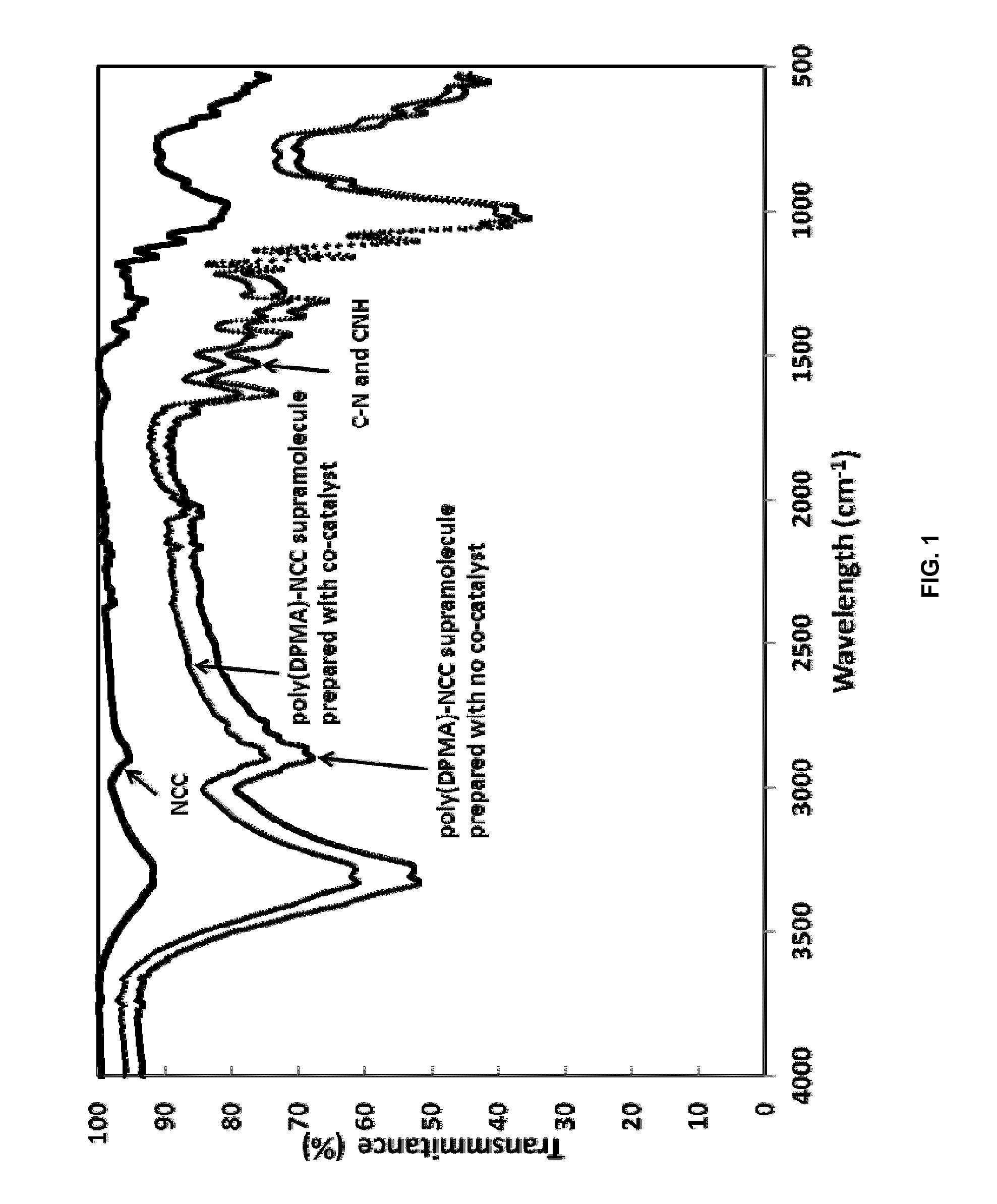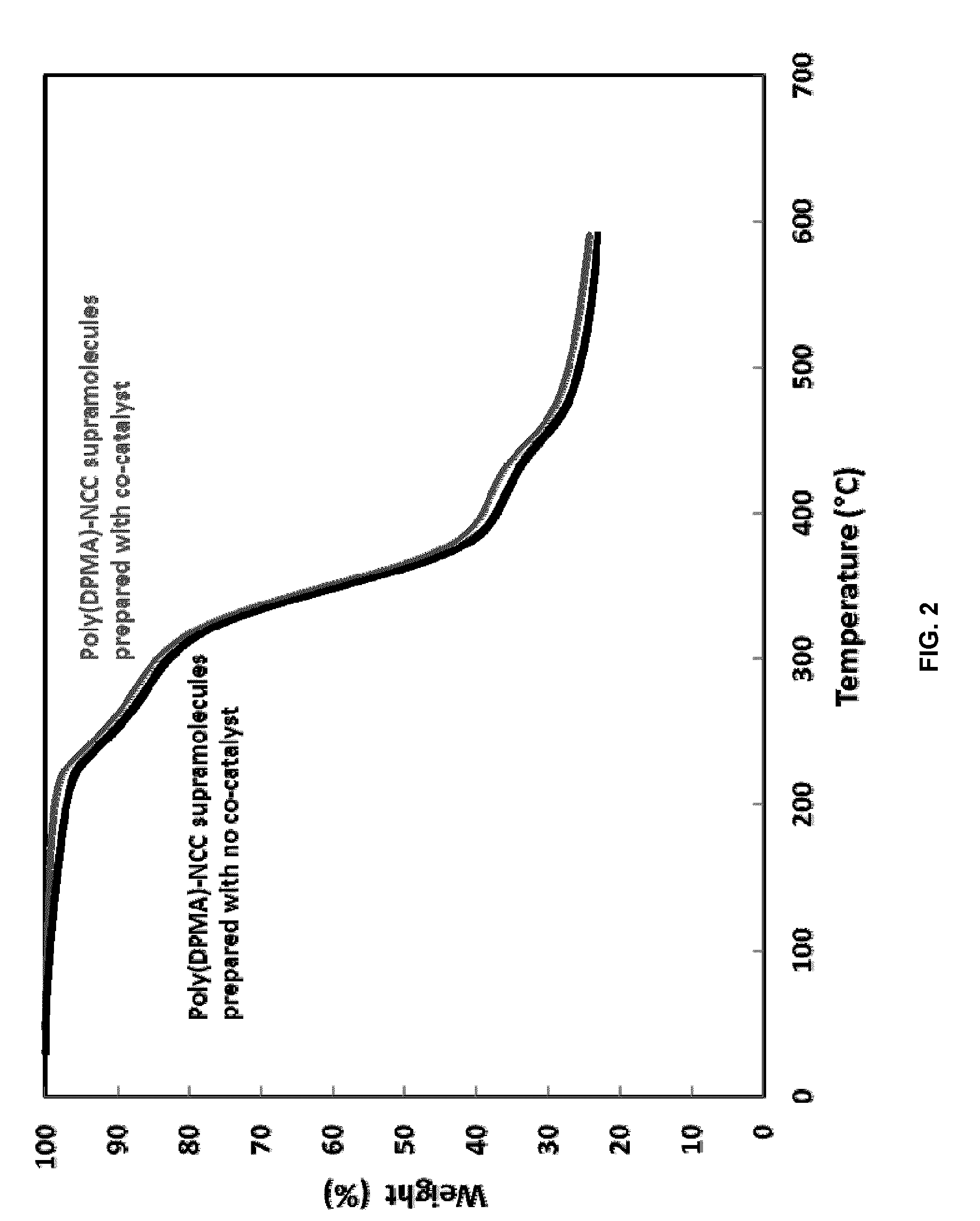Ncc as a functional scaffold for amine-cured epoxy nanocomposite materials of tunable properties
a technology of amine-cured epoxy and nanocomposite materials, which is applied in the field of functionalizing ncc, can solve the problems of aggregation of ncc particles, poor dispersion of hydrophilic ncc particles in mostly hydrophobic polymer matrices, and the application of ncc in composite manufacturing
- Summary
- Abstract
- Description
- Claims
- Application Information
AI Technical Summary
Benefits of technology
Problems solved by technology
Method used
Image
Examples
example 1
Preparation 1: Surface Graft Polymerization of NCC with N-[3-(Dimethylamino)propyl]methacrylamide (DPMA)
[0050]The reaction began by mixing an aqueous suspension of NCC at the required concentration with DPMA. The mass ratio of NCC to that of the monomer was 1:2 and NCC concentration was 3% w / w in this particular example. The pH of the reaction solution was pH 11.5.
[0051]The reaction was initiated using ammonium persulfate (APS) and the molar ratio of APS:DPMA is 1.2:100. The initiator was dissolved in DI water. Both APS and NCC solutions were then purged with nitrogen for 30 mins. The polymerization starts by adding the APS solution into the NCC solution. The reaction was then allowed to proceed for 18 hours at 60° C. After completion of the reaction, the solid material was centrifuged by adding acetone to obtain a 50 / 50 w / w acetone / water mixture. Centrifugation was carried out at 4,000 rpm for 30 min, and was repeated twice. The product was centrifuged once more with pure acetone t...
example 2
Preparation 2: Surface Graft Polymerization of NCC with N-[3-(Dimethylamino)Propyl]Methacrylamide Using Co-Catalyst
[0053]The reaction began by mixing an aqueous suspension of NCC at the required concentration with DPMA. The mass ratio of NCC to that of the monomer was 1:2 and NCC concentration was 3% w / w in this particular example. The pH of the reaction solution was pH 11.5.
[0054]The reaction was initiated using ammonium persulfate (APS) and the molar ratio of APS:DPMA is 1.2:100. The initiator was dissolved in DI water. Both APS and NCC solutions were then purged with nitrogen for 30 min. A co-catalyst, ammonium oxalate, at the ratio of 1:1 to APS, was first dissolved in DI water and quickly added into the reaction right before adding APS. The polymerization started by adding the APS solution into the NCC solution, and the reaction was allowed to proceed for 18 hours at 40° C. After completion of the reaction, the solid material was centrifuged by adding acetone to obtain a 50 / 50 ...
example 3
Preparation and Properties of Amine-Cured NCC-Epoxy Nanocomposite Systems
[0057]To prove the functionality of NCC poly(PDMA)-NCC supramolecular materials, amine-cured epoxy nanocomposite systems were prepared using NCC and poly(DPMA)-NCC. To further confirm the wide applicability of this novel approach, two epoxy systems were examined: A high-purity bisphenol A diglycidylether epoxy resin, and a semi-solid reaction product of epichlorohydrin and phenol-formaldehyde epoxy resin. Of the former type, we used one commercial epoxy resin, D.E.R. 332 (Dow Chemicals), and of the latter type, D.E.N. 438, an epoxy novolac resin (Dow Chemicals). In both cases, the hardener used was JEFFAMINE D-230 polyetheramine (Huntsman), which is a difunctional primary amine with an average molecular weight of about 230.
[0058]To prepare epoxy film samples, epoxy, hardener and NCC were mixed together in a suitable solvent, for instance, dimethylformamide (DMF). The resin and curing agent are reacted at approx...
PUM
| Property | Measurement | Unit |
|---|---|---|
| Fraction | aaaaa | aaaaa |
| Mass ratio | aaaaa | aaaaa |
Abstract
Description
Claims
Application Information
 Login to View More
Login to View More - R&D
- Intellectual Property
- Life Sciences
- Materials
- Tech Scout
- Unparalleled Data Quality
- Higher Quality Content
- 60% Fewer Hallucinations
Browse by: Latest US Patents, China's latest patents, Technical Efficacy Thesaurus, Application Domain, Technology Topic, Popular Technical Reports.
© 2025 PatSnap. All rights reserved.Legal|Privacy policy|Modern Slavery Act Transparency Statement|Sitemap|About US| Contact US: help@patsnap.com



